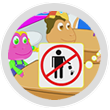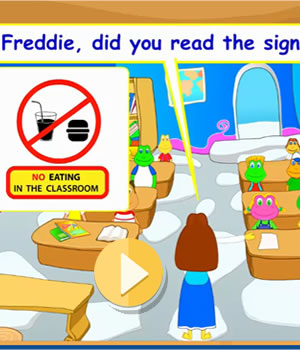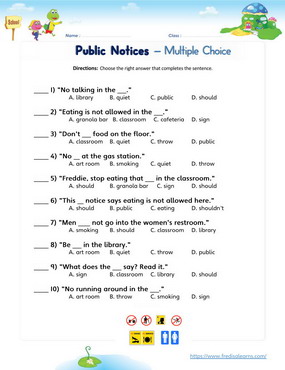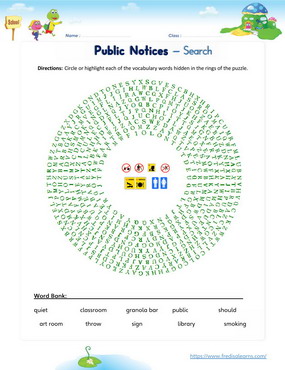Unit 3: Public Notices
Objectives:
- Teach ESL/EFL learners how to read public notices using the imperative mood and imperative sentences.
- The imperative mood is a verb form which is used when giving instructions, advice, commands or making requests. Imperatives are usually formed by using the infinitive form of the verb without ‘to’. Negative imperatives use ‘do not’ or ‘don’t’.
- Since imperative sentences do not generally sound polite, this lesson also teaches students to translate imperative sentences into fuller more polite sentences using modal verbs like ‘should’ and ‘be allowed to’. In imperative sentences, the subject of the sentence is not always clear.
- This ESL kids lesson also focuses on forming authoritative phrases starting with ‘no’.
Main Lesson Materials & Study Steps
1st –This cartoon animated video features a short dialogue, followed by vocabulary and sentence breakdown. It is essential for introducing the words, phrases, grammar, spelling and sentences of the lesson in context. Watch repeatedly to master the content. The video plays on any device.
2nd – Then the student plays this fun game after watching the video, to practice the contents of the lesson. The game reviews key vocabulary, grammar and sentences from the lessons. This game can be played on any device.
3rd – Finally the learner takes this test of the unit. The score of this test is captured in the LMS and gives educators an idea of how well their learner is doing. The test opens on any device – mobile & PC.
Worksheets for the Unit
The worksheets below are useful for offline and classroom activities. These printable exercises directly correlate with the above lesson 'Public Notices'. Every worksheet comes with an answer sheet on the second page for educators.
Already a Member?
Not a member yet?
Lesson Story:
On rare occasions Freddie becomes the bad boy and today is one of them. Miss Ann walks into class to find Freddie eating his granola bar at the desk. She tells Freddie not to eat in class. She points to the sign on the board. It says eating is not allowed in class. Then, Miss Ann takes the class to the library and shows the children the signs. The students get together and start making rules for different places in the school.
Vocabulary:
| sign |
| eating |
| quiet |
| public |
| classroom |
| library |
| bathroom |
| granola bar |
| men’s restroom |
| women’s restroom |
| food |
| cafeteria |
| smoking |
| gas station |
| art room |
Verb noun collocations
| read | the signs |
| be quiet | in the library |
| public | notices |
| put on | your shoes |
Key Sentences:
Forming Imperative Sentences
Public Notices Public Places
| Be quiet | in the library |
| Do not eat | in the classroom |
| No smoking | at the gas station |
| No running around | in the art room |
| Don’t throw food | in the cafeteria |
| No talking | in the library |
Imperative form Full Sentences (should & allowed)
| 1. Be quiet in the library. | 1. You should be quiet in the library. |
| 2. No eating in the classroom. | 2. Eating is not allowed in the classroom. |
| 3. No smoking at the gas station. | 3. Smoking is not allowed at the gas station. |
| 4. No running around in the art room. | 4. You shouldn’t run around in the art room. |
| 5. Don’t throw food in the cafeteria. | 5. Throwing food is not allowed in the cafeteria. |
| 6. No talking in the library. | 6. Talking is not allowed in the library. |
Dialogue Script
Freddie: This is so yummy.
Ms. Ann: Freddie, are you eating in my class?
Freddie: Yes, Ms. Ann.
Ms. Ann: Freddie, did you read the sign?
Freddie: No, Ms. Ann.
Ms. Ann: Class, this sign says there is no eating in my classroom. You have to read the signs that are posted when you go into a public place.
Sally: Like where, Ms. Ann?
Ms. Ann: Why don’t we take a trip to find out?
Ms. Ann: Freddie, will you read the sign?
Freddie: It says that if you aren’t wearing shoes, you won’t be served.
Ms. Ann: Why is it important to read that sign?
Sally: So you can put shoes on if you need to.
Ms. Ann: We have more signs near the bathroom. What do they say?
Sally: Men’s restroom.
Bob: Women’s restroom.
Ms. Ann: It’s very important to read this sign, what would happen if you didn’t?
Freddie: You’d go into the wrong bathroom!
Ms. Ann: Class, I would like for each of you to make a public notice for us to put around the school.
Freddie: Mine is going in the library. It will say “No talking in the library.”
Sally: That’s a good idea, Freddie. It’s important to be quiet in the library.
Bob: Mine is going in the art room. It says “No running with scissors.”
Freddie: That would be very dangerous! It’s a good idea to tell people not to do that.
Sally: Mine is going in the cafeteria. It says “Don’t throw food!”
Freddie: That’s good! I will eat my granola bar there next time, but I won’t throw it.
This lesson is part of the Level 4 English course.
In this English lesson, young learners will learn how to read and understand public notices using imperative sentences. The imperative mood is a verb form that is commonly used to give instructions, advice, commands, or make requests. Learners will be taught how to form imperatives by using the infinitive form of the verb without ‘to’. Negative imperatives are formed using ‘do not’ or ‘don’t’.
While imperative sentences are not generally polite, this lesson will also teach students to translate imperative sentences into fuller and more polite sentences using modal verbs like ‘should’ and ‘be allowed to’. Additionally, learners will be taught how to form authoritative phrases starting with ‘no’. It is important to note that the subject of the sentence is not always clear in imperative sentences.
By the end of the lesson, students will be able to read and understand public notices using imperative sentences. This will help them in understanding and following instructions given in public places such as parks, libraries, or malls. Moreover, it will aid them in developing their language skills and vocabulary, which are essential for effective communication.













